From Disney Princesses to Houseplants: More on Building Communication Opportunities
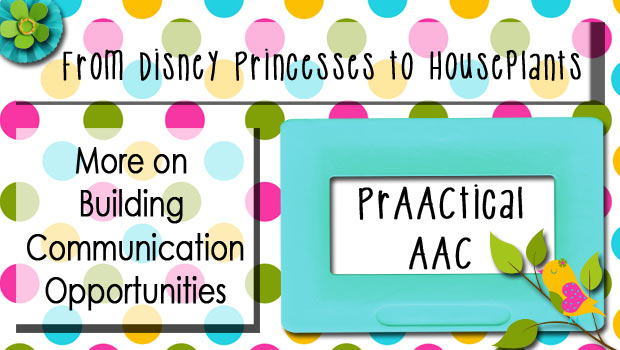
Mining everyday routines at home, in school, and in therapy sessions for communication teaching opportunities is a great way to get started in boosting the effectiveness of AAC intervention. We are inspired when we see clinicians enhance their clients’ learning by making subtle, but important changes.
–
I was thrilled to hear one SLP talk about how she ‘found’ more AAC practice for a teenager by offering more choices in her therapy games. Once he chose a TV character for the activity, LeVon then had to specify what action he/she would do (e.g., dance, drive, clap) and a location in which to do it (e.g., home, school, beach). Agent, action, location. Hmm…sounds like a good start for sentence-building, with a little aided language input and expansion thrown in for good measure. “Quinn drive beach.” “Yes. Quinn drove to the beach in his truck.” And it gives us great pleasure to see people modifying their activities using sabotage and other communication temptations to squeeze out more prAACtice.
–
In this post we talk about where to go from here. Specifically, we’ll talk about how to build communication opportunities for learners who have intense interests in particular topics as well as those who seem to have very few interests at all.
–
AAC Learners with Intense Interests
–
What do trains, dinosaurs, Glee, and the Hello Kitty have in common? You probably already guessed the answer: They’re all subjects of intense interest by some of our AAC friends. We’ve all worked with folks who are incredibly interested in or motivated by a particular topic. In all honesty, we’re perplexed when we hear a clinician or educator complain about this. “I don’t know what to do with Kristy. All she ever wants to talk about is Disney princesses. Ugh! I can’t get her to talk about anything else.” This is a problem?! Seriously, Calla Clinician, get your head on straight. With a little creativity, you can make this ‘annoying quality’ (huh?) into a therapy asset. (I’m no fan of Disney princesses, by the way, but if it works for the learner, I’ll use it in therapy to get her talking.) Here are some ideas to get you started.
–
1. Use a thematic approach: Instead of bemoaning Kristy’s love for the princesses, exploit it. Use princess pink treat or gift bags from the dollar store for activity materials. Decorate her schedule with princess stickers. Cover her speech homework folder with princess wrapping paper. Bury princess trinkets in the sand/rice table. Hang some princess party decorations on the wall. Use a princess placemat to sit on or read some princess books (interactively, of course). Make some princess crafts.
2. Modify board games to feature princess characters and change the rules to fit your purpose: Guess Who or Candyland, princess-style? Yes, please!
3. Adapt toys the same way. A few princess stickers on my dominoes, blocks, or lotto cards will get Kristy’s attention.
4. Write ‘princess-y’ stories using TarHeel Reader or Pictello. Make a PowerPoint with princess images and descriptors.
5. Use the princesses as characters and have them act out the action or sequence you’re targeting in therapy. Get or make some props and have Kristy tell Princess Jasmine what to say or do.
6. Choose a Princess of the Week and use her for language building. What does she look like? What does she like to do? Where does she live and who lives with her? Build sentences to practice core words and specific sentence structures. Pick a salient vocabulary word to teach (e.g., Jasmine is brave/strong/independent).
–
You get the idea. The way we see it is that intense interests are a clinician’s best friend. That doesn’t mean we allow princess talk when it is inappropriate or refrain from helping the person expand their interests, but we certainly do have fun building prAACtical opportunities when learners have intense interests and strong preferences.
–
Learners with Few Interests
–
What about those folks who don’t seem to like anything at all? Creating meaningful communication opportunities for AAC learning and practice takes on extra challenges when the learners have restricted interests.
–
One strategy that has worked beautifully for us is to help the person develop a hobby. The may not like it at first, but, with consistency, good intervention, and appropriate visual supports, they often come to really enjoy the new activity. We’ve found that you have to work closely with the family to choose an appropriate interest and have their support in developing it. Here are some of the things we’ve helped our AAC friends get interested in that have had big pay-offs for building communication and interaction skills.
–
1. Photography
2. Collections of things like shells, rocks, stamps, figurines, sports cards, or special pencils
3. Simple crafts, like making beaded jewelry
4. Model making
5. Exercise
6. Scrapbooking
7. Sports teams or events like the Olympics
8. Gardening, raising houseplants
–
Once you and the family decide on a hobby to cultivate, work on it in very, very small steps. Start with some aspect of the activity that is easy and rewarding in some small way. For example, when Jorge was a client in our clinic, I brought in a number of houseplants for him to water. That became his job and he was helped to water a few plants each week. Over time, we were able to develop conversations around planting seeds, caring for plants, and giving seedlings as gifts. We took pictures of him with the plants, built mini memory books together, and helped the group home staff sit and reminisce about them with him. It wasn’t a life-changing event, but it did give this older man with severe disabilities an authentic context for conversation. Seeing the look of pride as he shared his seedlings with others was priceless, but the real benefit was this: he now had something to talk about.
–
Having something to talk about launched a chain of new experiences: Because he had something to tell the receptionist (or van driver), he used his AAC to talk to them (with support, at first).
–
Because he talked to them about something (relatively) interesting, they responded positively.
–
Because they responded positively, he had incentive to keep talking.
–
Because he kept talking (with AAC), he got faster and better.
–
Because he was a faster, better conversational partner, more people stopped and talked with him. And so it goes. All that for a packet of seeds that cost less than a dollar.
–
Filed under: Strategy of the Month
Tagged With: intervention, Opportunities
This post was written by Carole Zangari

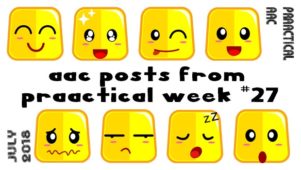
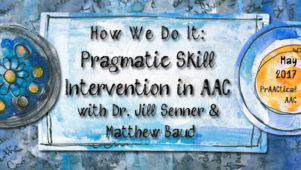
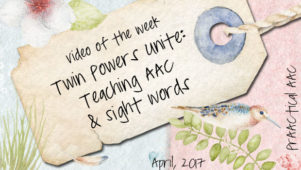
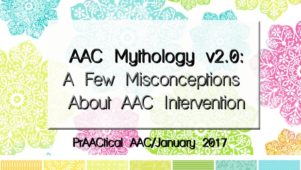
10 Comments
I really do love the Disney Princesses, and the memories from Disney World/Land will stay with you forever. Disney is always changing the top ten princesses too, and I read a new list was out here: http://thecelebritycafe.com/feature/2012/04/top-ten-disney-princesses. I dunno… Repunzel deserves to be on the list. Did you see her at Disney? That would be awesome!
Thanks for your comment, Sam. We’ve had some great trips to Disney World and Disneyland! You’re right-many lasting memories. Love using the Disneyland Explorer app with our kids, too! http://bit.ly/wWEsMx
I love the way you address helping your patients/students bridge general interests into actual hobbies. Do you know of any or have you thought of developing a rubric for systematically helping therapists and educators facilitate hobby and interest development in their students? It would be great to have an organized visual to share with our students’ families and teachers. That way we can all take note of how development of interests can lead to improved communication across communication functions.
Thanks again and I love the site!
Thanks for those comments, Colleen. The idea about using a rubric and systematic process for this is intriguing. I haven’t seen anything like that, but would be very open to trying it. To me, it’s more of a mindset of taking something that some people might see as a ‘negative’ (like an intense interest in clocks/time) and choose to see it as something positive (a way to make therapy more meaningful and motivating). I really, *really* like the idea of having some sort of visual support to guide the process. Thanks for that idea. If I developed something like that, would you be willing to take a look and give me feedback? So glad you like the site!!
I would be happy to check it out!
Sounds great! I will try to work on something like that this weekend. What is the best way to get it to you?
That sounds great! Send it to me through info@AllSpecialEd.com.
Thanks!
Will do. Headed into a busy time so it may be awhile but it would be great to get your feedback on this. Thanks!!!
Review by Aaron J. Hatch for Rating: We gave this gift to my 5 year old for her birthday and she spedns a great deal of time playing with it and talking about her color creations.I feel that there are definately more educational toys, however it definately keeps her occupied and happy.I love that it is encouraging her creative imagination and suggest if your little girl loves princesses and coloring, it is a great idea.
Great, I look forward to it! Have you seen the discovr music apps? I recently got it and found it to be super helpful in expanding interests of students. http://allspecialed.com/Forums/threads/318-Discovr-Music-music-and-leisure-app?p=609#post609